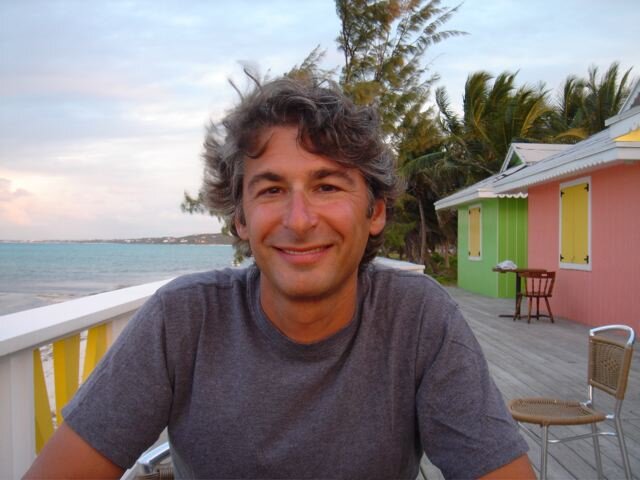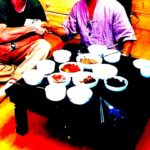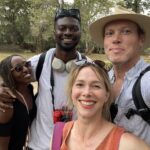James Sturz is a freelance writer and novelist. His travel articles have run in Travel + Leisure, Condé Nast Traveler, The New York Times, International Herald Tribune, The Boston Globe, Detour, Mondo, Bride’s, Cigar Aficionado, Blue and Lexus. He has also published widely, on a variety of subjects, in The New York Times Magazine, The New Republic, The New York Observer, Men’s Health, Playboy, Glamour, Marie Claire, Redbook, Entertainment Weekly, and many other publications. His first novel Sasso, a murder mystery/thriller set in a hilltop town in southern Italy, was one of The Sunday Telegraph‘s top picks for 2001. While at work on his second novel, similarly set in hard-to-get places, Sturz also teaches travel writing in New York City for Mediabistro.
How did you get started traveling?
The summer after my freshman year of college, a friend and I took off for eight weeks backpacking through Europe. As I explained to my skeptical parents before the trip, we weren’t going to see the sites and visit the museums, but lounge at cafŽs and on Mediterranean beaches. Then to my great surprise, I found that once I got to Europe, I did want to see the sites and visit the museums (as well as the cafŽs and the beaches). From that point on, I was hooked. I wanted to know the history and the languages and the cultures, and I wanted to see far more than I’d been able to cram into a Eurail trip. Soon it even occurred to me: there were other continents to visit beyond Europe, including my own, North America.
How did you get started writing?
I’d wanted to be a writer at least since high school, since reading the Herman Melville story “Bartleby the Scrivener” in tenth-grade English class. Nevertheless, my own experience was just the opposite of “preferring not to,” because on that same first exploration of Europe, I started writing everything down. Those dog-eared journals (and, yes, I still have them) became repositories for ideas and images as well as my rugged traveling companions. Today, I still keep journals packed with bits and pieces from my travels — as well as with assorted thoughts had at home — and I use them in my writing. Half a dozen years ago, I wrote a paean about eating meat for one New York magazine, and I filled the essay with scenes and other material I’d gathered from the preceding half-dozen years.
What do you consider your first “break” as a travel writer?
Upon graduating from college (Cornell, 1987), I headed back to Europe to teach English in Bologna, Italy for a year. I can’t say I wrote anything of real note while I was there, but I found my way into journalism once I returned. I worked as a fact-checker at Vanity Fair magazine from 1989 to 1991, all the while trying to get magazine and newspaper assignments as a freelance reporter. Editors wanted to know why I should be the one to write the various stories I was proposing, and soon my answer was because the stories were about Italy, I’d lived in Italy, knew the culture and spoke the language. At CondŽ Nast Traveler, one editor still asked me, “Why should we assign the article to you when we could have Gore Vidal do it?” But the New York Times Travel Section was willing to take a chance. And so was The New Republic for an article on Italian politics. Once those articles ran, I was off and running too. And my byline started reading, “James Sturz reports frequently on Italy.”
As a traveler and fact/story-gatherer, what is your biggest challenge on the road?
Nowadays, as a writer, I’m convinced that description gets boring without a storyline, or at least without characters and a little action. Perhaps I believe this because I also write fiction, but I think I’d feel the same way even if I didn’t. So my biggest challenge on the road isn’t ever the technical issue of getting from Point A to Point B, or of saying what’s so pretty or interesting about either one. It’s the larger, more writerly issue of recognizing the narrative while I’m in the right place to get it, and then of making sure that once I’m at my desk I already know where my story’s going. Because nothing’s more boring than a travel article stuffed with dates, population figures, descriptions of buildings, horizons, trees — and nothing else.
What is your biggest challenge in the writing process?
I always come home from trips with too many notes, too much information, and from an editorial standpoint, never enough words to do the subject justice. So the process of writing is as much a ruthless process of cutting away — of saying, perhaps, “This is great. But great for another article.” Because no matter how interesting, not everything can fit into a magazine article. But it’s different with books. My first novel Sasso was based on a travel article I wrote for the New York Times about the southern Italian town of Matera. When it was time to expand, one of the secretly gratifying experiences of writing it was being able to put back everything I’d cut for space. (Of course, for the book I had to put a lot more in, too — and that provided a rare travel experience for me, one of writing about a town and then returning.)
What is your biggest challenge from a business standpoint?
With magazine writing, the biggest challenge is getting the assignments I really want to write: envisioning a story and then convincing an editor to assign it and run it just the way I see it. From a purely business standpoint, the challenge is keeping an eye on cash flow, particularly when I’m waiting for checks for my text and for my expenses. For book writing, though, the biggest challenge is promotion. People read magazines because of the mix of articles in any given issue — or simply because they already have a subscription, and the magazine’s going to arrive at their door — but they buy my books only because of me. So that means doing my best to get the word out (hey, readers, please visit my website).
Do you do other work to make ends meet?
Professionally, I do three interrelated things. First, I write freelance travel articles for newspapers and magazines. Second, I write novels, including Sasso and my nearly completed second, which, like Sasso, relies heavily on travel and a sense of place. Third, I teach travel-writing seminars in New York City for an outfit called Mediabistro, which offers classes around the U.S. and in Canada. At this point, I’d say I earn 33 percent of my income from each of those three, plus a remaining 1 percent from the sale of photos illustrating articles I write.
What travel authors or books might you recommend and/or have influenced you?
American: Ernest Hemingway, Jack Kerouac, Herman Melville, John Steinbeck. British: Bruce Chatwin, Norman Douglas. Greek: Homer. Italian: Carlo Levi. Uruguayan: Eduardo Galeano.
What advice and/or warnings would you give to someone who is considering going into travel writing?
Know why you want to go into travel writing. If it’s because you love to travel, the truth is you might be better off working as a travel agent or teen-tour operator (or soldier or pilot or diplomat or cruise director). A much better reason to go into travel writing is because you love to write, because that’s what you’re going to be doing more than anything else. If you love to write descriptive prose, that’s even better.
What is the biggest reward of life as a travel writer?
There are two. One is traveling to hard-to-get places with the sole agenda of seeing them as fully as I can, often without having to worry about daunting issues like cost. That genuinely feels like a gift. But the second reward is succeeding at capturing those adventures in words. Last fall, I wrote a magazine article about snorkeling in Maui with my wife (and, yes, the magazine sent the two of us there from New York). I described her as “Esther Williams in a glitter of fish.” It’s using language afterwards that adds the fun to the fun.





